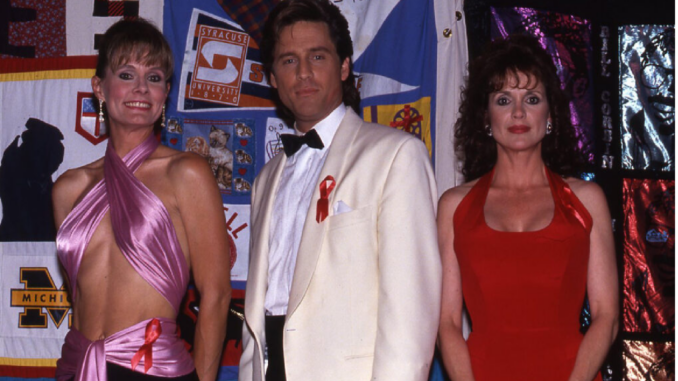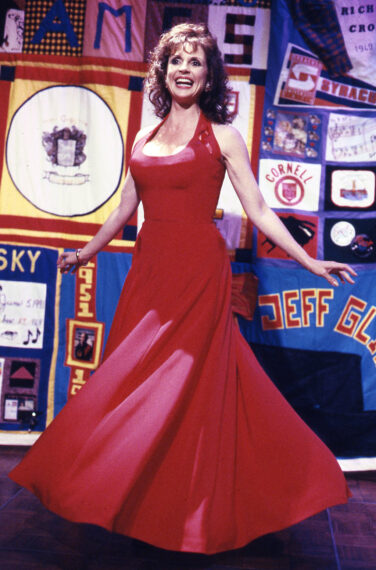
Thirty years ago, General Hospital‘s creative team – at the time, Wendy Riche, executive producer, and head writer Claire Labine – brought the Nurses’ Ball to daytime TV. Hosted by Lucy Coe, played by Lynn Herring, the event brought citizens of Port Charles together as they lent their impressive musical talents to a worthy cause.
Other daytime dramas had addressed the issue of AIDS/HIV before, starting with nurse Noreen Donovan (Marilyn McIntyre) on Loving, but General Hospital told an ongoing story with the Nurses’ Ball. A year after the first Nurses’ Ball in 1994, the show took Robin and Stone’s love story in a powerful direction when Stone (Michael Sutton) died from AIDS, and Robin (Kimberly McCullough) was diagnosed as HIV-positive.
TV Insider chatted with Scott Barton, the show’s former publicist, who had previously worked with Elizabeth Taylor (ex-Helena Cassadine) in 1985 on the Commitment to Life fundraiser for AIDS Project Los Angeles (APLA), about the Nurses’ Ball, how it came to be, and its enduring legacy.
How did the idea for General Hospital to do a fundraiser within the show to help bring awareness and research for AIDS/HIV come about?
Scott Barton: I believe it was Claire’s idea [after actor] Neil Tadken had come up with the idea for the Day of Compassion which took place every year [from 1993 to 1999] on June 21 to honor people who were fighting AIDS or were HIV positive. In a meeting, I went on to suggest that Bobbie [Jacklyn Zeman], a nurse, could wear the [red] ribbon on-air and that maybe a mention of it could be made. I went to Jackie and asked her if she was okay with that and, of course, she said, “Absolutely!”
It exploded from there. It lit a fire under [late costumer] Bob Miller and [costumer] Steve Howard because that gave them free license to go crazy with ball gowns and costumes. Everybody just fell in love with doing these shows because it was at a time when nobody felt that they had anything to contribute [to the AIDS crisis].

Vivian Zink /American Broadcasting Companies via Getty Images
All My Children had done an AIDS story with Ellen Wheeler (ex-Cindy) and As the World Turns had the AIDS Ball but GH’s Nurses’ Ball became a staple of the show.
I had many hours of conversations with Claire about what we could do to bring the [Nurses’ Ball] more to life like bringing on Ryan White’s mother, Jeanne, on as herself. She’s still a friend of mine. That was my contribution. I was just in the right time at the right place. Everybody at the show was behind this 100%.
The talent program within the show gave actors opportunities to showcase their talents. We already knew Wally Kurth (Ned) was a great singer and that Stuart Damon (ex-Alan) had been Prince Charming in Cinderella. Other actors shined in the Nurses’ Ball, too.
We knew that they were singers in the cast. Brad Maule [ex-Tony] had had a very successful stage musical career. But I didn’t realize to what extent everyone in the cast had something in them Even [the late] John Beradino [ex-Steve, a former real-life baseball player] performed “Casey at the Bat” [the poem by Ernest L. Thayer]. Actors were going up to Claire, telling her that I can do this or that. To Wendy’s credit, the show got so much in.
And can you talk about the late Lee Mathis and his role as Jon Hanley on the show?
Lee had put an ad in Variety asking for work to extend his health care benefits. Gwen Hillier in the show’s casting department had seen it and she mentioned it. I knew Lee prior to this and of his situation. I felt he’d be great to come on as Jon Hanley. Gwen and [casting director] Mark Teschner had him come in. The show wrote a part for him, and it really helped him out. It renewed his insurance, gave him some money, and gave him a place to go and have some self-esteem, confidence, and a purpose.
I remember the day he shot his speech at the Nurses’ Ball. He was psyching himself out. I had gone to the set to wish him luck. He said, “Scott, I don’t think I can do this.” I told him he was doing this for all our friends who were gone. I said, “Just let it go and let them speak through you. You’re here for a reason.” He went out there and did it in one take.
Cast members were crying because they hadn’t heard it before. It moved everybody. They wrote several more episodes for him because he’d done such a great job. People took to his character, and I was really happy when they did an honorarium to him after he died. People Magazine had written about him. It made me happy to know that at the end of his life, he had gotten national attention for his career.
This storyline allowed viewers to see a different side to Lynn Herring’s Lucy. We saw Lucy care about other people in a way that we’d never had before.
I think that really came out at the Nurses’ Ball. We also saw Jackie Zeman’s down-home-elegance. That was really evident.
Were there little touches viewers might not know about?
Yes. Bob Miller somehow got in touch with a clothing manufacturer who donated tuxedo shirts for the men. Woven into the fabric of the shirts were itty bitty stopwatches and underneath them [were the words] “Stop AIDS.”
Robin and Stone performed a scene from Romeo and Juliet in the first Nurses Ball.
The following year, Stone died from AIDS, and Robin was diagnosed HIV positive. What were your thoughts on the show writing Robin being positive?
Honestly, I insisted on it. I’m not trying to take credit for it, but I remember being in a meeting with Wendy and Claire and I don’t know who else was in there, but they were all talking about it. I said she absolutely has to [be positive]. It’s not likely that she would not test positive. Robin and Stone were having unprotected sex. I felt it you didn’t you’d be completely pulling the rug out from under this whole storyline. If she tests negative, you have just flushed every effort and every Lee Mathis down the drain.
Robin doesn’t have to die but instead, she can become a leader on how you can live with HIV and [show] how people respond to someone who is positive. Let’s move this story forward in a way that no one has ever done before. I’d been personally affected by scores of friends dying and had been in the trenches at that point for a decade. That was the most adamant I’d ever felt about anything.
Frank Valentini, executive producer, and then-head writer Ron Carlivati revived the Nurses’ Ball in 2013 after it had been dormant for many years. What did you think of that decision?
I’ve met Frank a few times. I admire his directness. He’s very clear thinking and he knows what he wants. I think it was very smart of the show to bring back the Nurses’ Ball in a number of ways. It shows the continuity of a daytime dramatic series. It shows continuity of the characters that’s in keeping with the hospital [backdrop]. It makes sense as a fundraiser. It’s a great legacy for the show and there is always a need for medical care and the costs of research. And it’s a great opportunity again to allow the actors and characters to show sides of themselves that nobody has seen before.

Rick Rowell /American Broadcasting Companies via Getty Images
Since you’d worked with Elizabeth Taylor, was there any effort to have her reappear on the show during the Nurses’ Ball as Helena Cassadine? Her appearance as Helena at Luke and Laura’s (Anthony Geary and Genie Francis) 1981 wedding was legendary.
It came very, very, very close.
Really?
Oh, yeah, I mean, it was almost scheduled and then something fell apart. I recall that it was [tentatively scheduled for the end of the day. But something happened and it got scrapped. She was absolutely up for doing it. It was scheduling. I don’t remember what it was but Elizabeth was not someone who would flake. I mean…she’d show up [eventually]. [Laughs] I called it “EST — Elizabeth Standard Time.” She really did want to do it. She had a very soft spot for the show and for that character.
What other authenticity did you help bring to the Nurses’ Ball?
I arranged with the NAMES Project AIDS Memorial Quilt [people] to have panels from the quilt brought down and use for the backdrop of the Nurses’ Ball. I don’t know if people are aware of this but whenever the quilt is displayed there’s a whole ritual of how they do it. It’s like an origami in reverse. They installed it in the middle of the night to set it up for the next day’s filming.
The next morning, I remember standing on set with two actors and one said that the art department did an amazing job of making it because it was so huge. I said, “No, they didn’t make it. That’s the real quilt.” Word had spread out throughout the whole building that the quilt was there and there was so much reverence when the cast was called to set and we began taping.
Cast members admired the quilt, appreciated it and they were wondering what the stories were in each panel. It really added a whole other layer of empathy, compassion, and reality to the entire taping. I am so grateful to Claire, Wendy, and Shelley Curtis [producer], the ABC executives, and everybody at GH for doing this.
